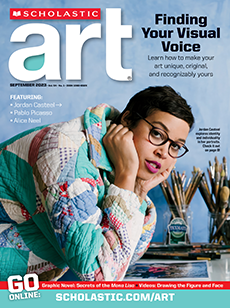When Tim Rollins was 26, the American artist and teacher created an after-school program for students at risk of dropping out. In the program, the students explored literature through artistic expression. They called themselves “Kids of Survival” (K.O.S.), and soon, Rollins and K.O.S. began collaborating on artworks. Their work was so powerful that a New York City art gallery began selling it to collectors.
K.O.S. members changed over time, but the group’s process stayed the same. They began with a discussion about an iconic text and then created art inspired by the discussion. They often incorporated pages of books, sheet music, and other printed materials into their work.
Their 2008 I see the promised land (after the Rev. Dr. M. L. King, Jr.) Triangle, above, is a collage including pages of a sermon by civil rights activist Martin Luther King Jr. The artists paint a triangle on the printed pages, which become a textured background. In his sermon, which is also known as “I’ve been to the mountaintop,” King talks about having a vision of societies that are equal and just—the promised land, or the mountaintop. How do the artists illustrate their interpretation of his words?
